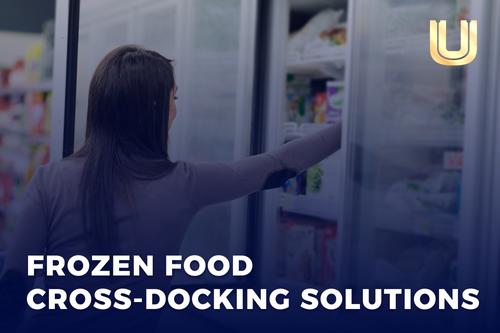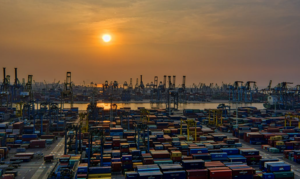FROZEN FOOD CROSS-DOCKING SOLUTIONS

Now more than ever, speed and efficiency are paramount considerations in supply chain operations for all organizations. This is especially the case of cross-docking strategies for frozen food products.
The pandemic impacted frozen food products in a big way. It increased the demand for frozen goods as people cook more at home and rely on shelf-stable items. At the same time, it disrupted supply chains and made it difficult to get products to market quickly. Furthermore, delays at ports, rails and airports have put even more pressure on the system.
In response, many organizations have turned to cross-docking as a way to speed up their operations and get products to market faster. Cross-docking helps reduce the time products spend in storage, which is important for frozen food transportation.
What is cross-docking?
Cross-docking is a supply chain strategy where products are transferred from inbound trucks directly to outbound trucks with minimal handling in between. There are many benefits of cross-docking for frozen food transportation, including:
- Reduced time in storage: By transferring product directly from inbound trucks to outbound trucks, cross-docking helps to reduce the time products spend in storage. This is important for frozen food transportation, as these goods can deteriorate when stored for long periods of time.
- Reduced handling: By minimizing the amount of handling required, cross-docking helps to reduce the risk of damage to products. This is especially important for frozen food transportation, as products can be delicate and can be easily damaged.
- Increased efficiency: Cross-docking helps to increase the efficiency of the supply chain by reducing the time required to move product from inbound trucks to outbound trucks. This is important for frozen food transportation, as it helps to get products to market quickly.
- Reduced costs: By reducing the time products spend in storage and the amount of handling required, cross-docking helps to reduce the overall costs of the supply chain. This is important for frozen food transportation, as it can help to reduce the cost of product transportation.
Frozen Food Shipping in 2022
2022 has seen its share of logistic troubles despite being on the tail-end of the pandemic. For example, a shortage in diesel fuel due to the prior year’s hurricanes led to higher prices and disruptions in supply. This, in turn, impacts frozen food commodities as diesel is used to power the trucks that transport these goods.
In response to these challenges, many companies are turning to alternative fuel sources such as electric vehicles to power their trucks. But even yet, transitions on a global scale are notoriously slow. And so, prices continue to fluctuate and remain on the high. There are many factors to consider in regards to 2022 as we enter the final quarter. What if a tariff war emerges again? What if a new pandemic emerges? Further strain means higher costs and longer delays – two things the frozen food transportation industry needs to consider.
What is the point? If we have learned anything in the last 3 years it’s that efficiency, optimizations and options are key in maintaining the supply chain line tight. Frozen food in particular benefits from this for obvious reasons. But why is cross-docking so critical when it comes to this commodity?
Why is frozen food cross-docking such a critical operation?
Run of the mill cross-docking operations involve the unloading of materials from an incoming semi-trailer, sea container and loading these materials directly into outbound trailers, sea containers or flatbeds. The complexity of these operations is magnified when the commodity is a frozen food grade commodity. Time and temperature considerations coupled with coordinating the proper refrigerated logistic equipment are a few of the factors that make designing frozen food cross-docking solutions so critical. When long term storage is not a factor in the logistic plan, expertly coordinated cross-docking operations are a must in order to avoid compromising the integrity of the food-grade commodity and avoiding costly delays.
We can help you develop a comprehensive technology-based strategy designed to improve efficiencies ensuring that your direct-to-consumer frozen foods stuffs are cross-docked and on the road in the timeliest manner. Our portfolio of turnkey solutions involving drayage, OW strategies, cross-docking operations and final mile delivery make us the perfect partner in helping you design a supply chain plan for your frozen food business.


